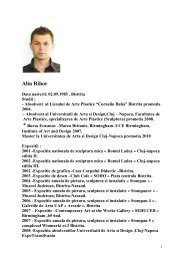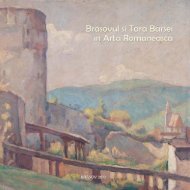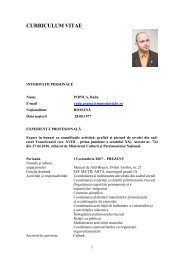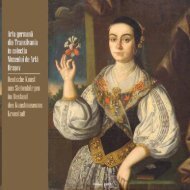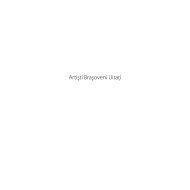Catalog Hans Eder PDF - Muzeul de Arta Brasov
Catalog Hans Eder PDF - Muzeul de Arta Brasov
Catalog Hans Eder PDF - Muzeul de Arta Brasov
Erfolgreiche ePaper selbst erstellen
Machen Sie aus Ihren PDF Publikationen ein blätterbares Flipbook mit unserer einzigartigen Google optimierten e-Paper Software.
Peisaj marin cu cactuşi<br />
Seebild mit Kaktus<br />
Seascape with Cacti<br />
<strong>Muzeul</strong> Naţional Brukenthal Sibiu<br />
Nationales Brukenthal Museum Sibiu<br />
the National Brukenthal Museum, Sibiu<br />
Nr. catalog 31<br />
Partida <strong>de</strong> cricket<br />
Die Kricketpartie<br />
The Cricket Game<br />
<strong>Muzeul</strong> Naţional Brukenthal Sibiu<br />
Nationales Brukenthal Museum Sibiu<br />
the National Brukenthal Museum, Sibiu<br />
Nr. catalog 30<br />
wären. Eisenteile, Rohre, Kabel und<br />
Mauern sind nicht mehr an ihrem platz.<br />
Das glühen<strong>de</strong> Metall ist in an<strong>de</strong>ren als<br />
die von menschlicher intelligenz und<br />
Geschicklichkeit ersonnenen Formen<br />
erstarrt. Die Stadt ist nicht mehr feindselig,<br />
son<strong>de</strong>rn vom Untergang bedroht<br />
wie es vor<strong>de</strong>m die Natur war. Die Kolomeea<br />
gewidmeten Bil<strong>de</strong>r zeigen eine<br />
starke dramatisch-kontemplative prägung.<br />
ohne personen darzustellen, erinnern<br />
sie an callots zyklus „Die Schrecken<br />
<strong>de</strong>s Krieges” und Goyas „Die Grauen<br />
<strong>de</strong>s Krieges”.<br />
Europa war mit Begeisterung in <strong>de</strong>n<br />
Krieg gezogen. Man machte sich ein<br />
philosophisches Konzept zu eigen 16 ,<br />
das, zum teil auch vom Expressionismus<br />
übernommen, die zerstörung als<br />
voraussetzung für <strong>de</strong>n Wie<strong>de</strong>raufbau<br />
<strong>de</strong>finierte, <strong>de</strong>r Krieg wur<strong>de</strong> als Mittel<br />
betrachtet, die alte ordnung <strong>de</strong>r Unterdrückung<br />
zu beseitigen, aus <strong>de</strong>ren<br />
Ruinen dann eine neue Gesellschaft<br />
erwachsen sollte. Durch <strong>de</strong>n Kampf <strong>de</strong>r<br />
Soldaten Seite an Seite im Schützengraben,<br />
sollte die Jugend die Überwindung<br />
<strong>de</strong>r Klassenschranken <strong>de</strong>r bürgerlichen<br />
Gesellschaft erfahren, doch wur<strong>de</strong> er<br />
zum trauma <strong>de</strong>r Künstlergeneration<br />
vom Beginn <strong>de</strong>s 20. Jahrhun<strong>de</strong>rts, das<br />
ihr Leben, Denken, Schaffen, ihre Wahrnehmung<br />
<strong>de</strong>r Wirklichkeit prägte. <strong>Hans</strong><br />
<strong>E<strong>de</strong>r</strong> nimmt als Berichterstatter am Krieg<br />
teil. in <strong>E<strong>de</strong>r</strong>s Werk bil<strong>de</strong>n die obsession<br />
<strong>de</strong>r leeren Blicke, die anatomischen<br />
Deformierungen, die Wahl vorwiegend<br />
kalter Farben - Grautöne o<strong>de</strong>r schreiend<br />
rote Kontraste -, die überraschen<strong>de</strong> zusammenstellung<br />
verrenkter Formen, die<br />
am häufigsten eingesetzten Mittel zur<br />
Europe had embarked on the war<br />
with enthusiasm. the Expressionists<br />
embraced one of the popular philosophies<br />
of the time 16 which contemplated<br />
distruction as a condition<br />
for reconstruction; war was to remove<br />
the old, opressive or<strong>de</strong>r so that, form<br />
its ruins, a new society could emerge.<br />
the experience of soldiers fighting in<br />
the trenches of the war, shoul<strong>de</strong>r to<br />
shoul<strong>de</strong>r, should have been sublime:<br />
the common, united action of young<br />
people transcending the barriers of<br />
bourgeoise society. in fact, war turned<br />
out to be a traumatic experience for<br />
the generation of artists active at the<br />
beginning of the 20 th century: it left its<br />
mark on their lives, on their vision of<br />
reality, on their manner of expression.<br />
<strong>Hans</strong> <strong>E<strong>de</strong>r</strong> was a war reporter. the<br />
obsessive, empty eyes, the anatomical<br />
<strong>de</strong>formities, the predominance of cold<br />
colours – in greys or in aggressive<br />
contrasts of red, the astonishing<br />
compositions, with twisted shapes,<br />
are <strong>E<strong>de</strong>r</strong>’s most common ways of<br />
expressing the dramatism of war. in<br />
these compositions, the landscape<br />
is adapted to the theme, it amplifies<br />
its dramatic dimension, even though<br />
it is often reduced to the empty, arid<br />
background of an opaque sky.<br />
the painful aggressiveness of the<br />
image in Retreat of the Austro-Hungarian<br />
Troups 17 , is given mostly by the<br />
sorry mass of soldiers in their blue<br />
uniforms, with frightened or grave<br />
faces, barely sketched, yet expressive,<br />
almost grotesque, and summarily<br />
differentiated. the foreground, in<br />
which the characters are placed, is



